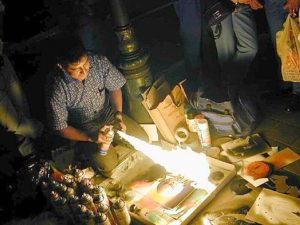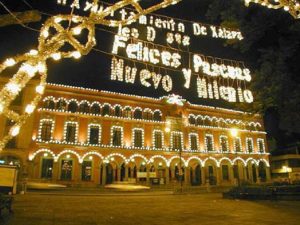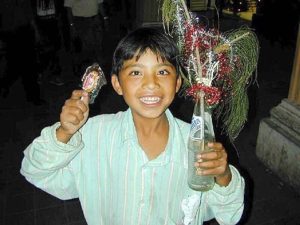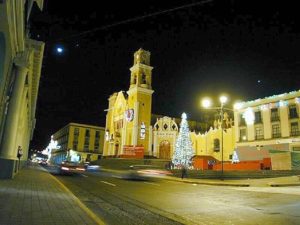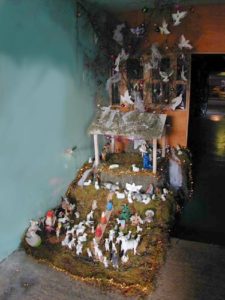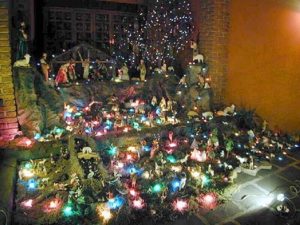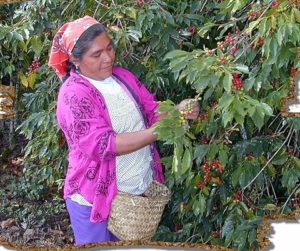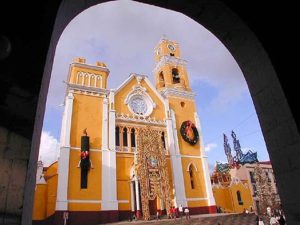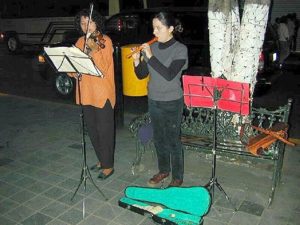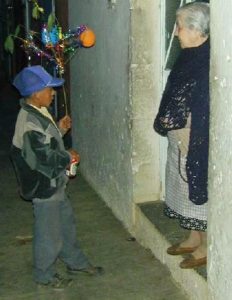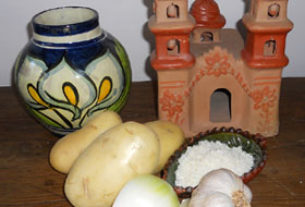The sights, sounds and smells of Christmas in Mexico are wondrous, and Xalapa is no exception. Sparkling lights, music, cohetes (fireworks) and hot chocolate mix together to fill your senses. All Saints Day (Todos Santos) in early November ushers in the Christmas season and from then on a torrent of events seem to happen at the same time. Wandering around the city, you’re bound to stumble upon a fiesta almost every day during the month of Diciembre. Following are some of the holiday traditions celebrated in Xalapa.
12 de Diciembre
December 12th marks the Día de Virgen Guadalupe, when Mexico’s revered Mother of Christ birthday is celebrated. In Xalapa long processions of pilgrims begin on December 10th with Coronas (crowns) from 3 to 6 feet tall made of bright, beautiful flowers lovely crafted by local artisans. Most of the processions are made by different sindicatos (unions) such as the electricians, taxi and bus drivers, city and state workers as well as barrios (neighborhoods), often causing hour long traffic jams as they slowly parade down the main streets singing songs of homage to the Virgin Mary on their way to the Capilla de Guadalupe in the barrio del Dique.
La Rama (The Branch)
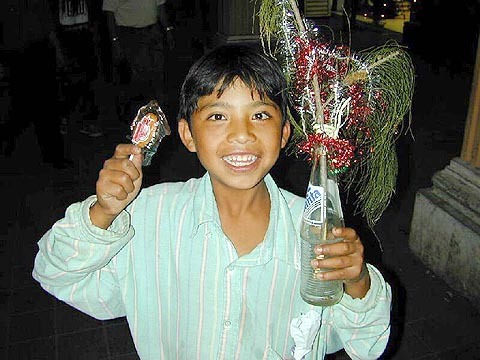
A custom familiar mostly to the state of Veracruz, La Rama is a tradition that begins on the 16th and continues until the 23rd of December (along with the Posadas and Pastorelas: please see other Mexico Connect articles) and is usually done by youngsters from age 6 to 16 who take a branch from some tree or bush, adorn it with tinsel, ballons, Spanish moss, silver stars or bright ornaments and perhaps a farolito (paper lamp). They then go from house to house in the evening singing songs accompanied by a tamborine, bottle caps on a wire as rattles, or perhaps a guitar and the ubiquitous glass FANTA bottle as a maraca, all in hopes of receiving an aquinaldo (bonus) consisting of money or perhaps mandarin oranges, apples, sugar cane, toys, or candy.
The song begins:
Buena noches decimos señores,
la rama les viene a cantar;
les viene a cantar sus honores,
¡A ver qué le puede usted dar!
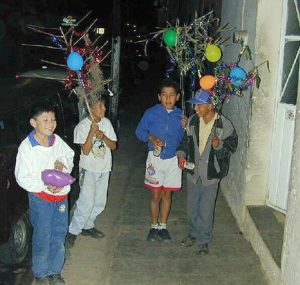
Good evening, we say, gentlefolk,
the branch comes to sing to you
it comes to sing with honor
to see what you can give us.
Then the verses continue:
Naranjas y limas
limas y limones
más linda es la Virgen
que tadas las flores.
Oranges and lemon
lemons and limes
the Virgin is prettier
than all the flowers.
En un portalito
de cal y arena
nació Jesucristo
por la Nochebuena.
In a small stable
made of lime and sand
Jesus Christ was born
on Christmas Eve.
A la media noche
un gallo cantó
y en su canto dijo
ya Cristo nació.
At midnight
a rooster sang
and in his song said
that Christ was born.
Arriba del cielo
está un portalito
por donde se asoma
el Niño chiquito.
Up in heaven
there’s a little stable
where he’s looking down
on the little boy (Jesus).
Zacatito verde
lleno de rocío
el que no se tape
se muere de frío.
Green grass
covered with dew
he who doesn’t cover up
will die of cold.
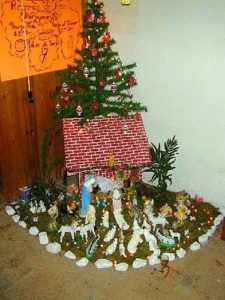
Denme mi aguinaldo
si me lo han de dar
la noche es muy corta
y tenemos que andar.
Give me my bonus
if you’re going to give it to me
the night is very short
and we have to go.
When the group has finished the verses, they wait a moment so that the owner of the house can open the door and gives them the much awaited aguinaldo. Once they’ve received it they sing the following farewell:
Ya se va la rama
Muy agradecida
Porque en esta casa
Fue bien recibida.
The branch is now leaving
very thankful
because at this house
it was well received.
However, if the owner doesn’t come out to give them the aguinaldo, the group sings:
Ya se va la rama
Muy desconsolada
Porque en esta casa
No le dieron nada.
The branch is now leaving
very sad
because in this house
they didn’t give it anything.
Or they may sing mischievously:
Ya se va la rama
Con patas de alambre
Porque en esta casa
Se mueren de hambre.
The branch is now leaving
with feet of wire
because in this house
the people are dying of hunger.
Since Xalapa is a university city, many of the music students get together and sing La Rama in wonderfully stylized versions through the downtown streets. Of course there are other verses in the different regions of the state of Veracruz. Many years ago the tradition of La Rama continued until January 6th when the Reyes Magos (Three Kings) arrived to see the newborn Christ, and of course leave gifts for well behaved children.
As with many traditions in Mexico, La Rama was an extension of Aztec rituals, in this case versúchil, a festival in December commemorating the rebirth of nature. The flower of the maguey (agave plant), which is quite large, was used instead of the branch which is used today. La Rama we know today began in the Sotavento area of Veracruz, especially in the beautiful riverside town of Tlacotalpan where a strong Afro-Caribbean flavor was added, then extended to the port city of Veracruz and then to Xalapa about 50 years ago, promoted by Doña Rafaela Murillo in its present version.
El Viejo (The Old Man)
Another wonderful tradition typical of this region is El Viejo started in 1875 in the Port of Veracruz as a social protest by workers, with clanking cans and loud drums. They asked for Christmas bonuses outside the home of a rich factory owner who was celebrating his Christmas Eve dinner. The tradition lost it’s political aspects and became more what it is today when a Korean who lived in Veracruz dressed up like the old man representing the old year in a Japanese almanac that he had. He would parade through the streets on the last day of the year followed by a little child representing the New Year, along with a noisy group playing guitars and güiros, banging pans or setting off cohetes and singing the following verses asking for their aguinaldo:
Una limosna
para este pobre viejo,
una limosna
para este pobre viejo,
que ha dejado hijos,
que ha dejado hijos,
para este año nuevo.
An alm
for this poor old man,
An alm
for this poor old man,
who has left children,
who has left children,
for this New Year.
Today the Old Man is usually accompanied by an Old Woman carrying a baby doll; the actors being generally university students dressed up with incredible masks and old clothes, followed by a group of students going from store to store in downtown Xalapa asking for their aguinaldos. It’s a fun tradition where you gladly give your loose pesos and tostones (50 centavo coin) to this happy crowd ushering in the New Year.
Well, I hope you’ve enjoyed a little of Xalapa’s Christmas. There are many more traditions I wish I could have written about in this article, but I’ll try my best to write more very soon from this wonderful corner of Veracruz. ¡Hasta pronto!


